Debate Analysis Tool
elections.nytimes.com/2008/president/debates/first-presidential-debate.html
New York Times
Andrew DeVigal, Gabriel Dance, Tom Jackson, Shan Carter, Matt Ericson
The New York Times created this tool that allowed users to watch 2008 presidential debates and speeches on demand with the transcript scrolling simultaneously alongside. Users have the option to search the text or jump to a specific part of a speech or debate to find topics most important to them, something that cannot be done with video alone. The project is easily replicable for future debates and speeches.
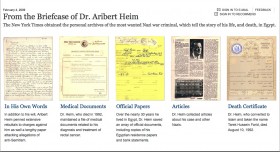 Document Reader
Document Reader
www.nytimes.com/interactive/2009/02/04/world/africa/20090204-nazi-documents.html
New York Times
Aron Pilhofer, Ben Koski, Alan McLean, John McGrath
“Document Reader” allows readers and news organizations the freedom to post documents of all sizes in a clean interface that allows searching, book marking, comments, and annotations (reporters can highlight and annotate passages they found important). Document Reader is part of the related project called Document Cloud and ProPublica (partners) are beta testing Document Reader on its site, which if the project goes well it will be launched in late summer or early fall. They have published 77 documents since March. Other examples: documents.nytimes.com/c-i-a-reports-guidelines-for-interrogators#p=1
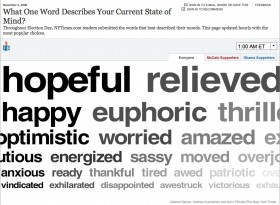 What One Word Describes Your Current State of Mind?
What One Word Describes Your Current State of Mind?
www.nytimes.com/interactive/2008/11/04/us/politics/20081104_ELECTION_WORDTRAIN.html
New York Times
Gabriel Dance, Andrew Kueneman, Andrew DeVigal
On Election Day, NYTimes.com users were asked to answer a simple question: “What One Word Describes Your Current State of Mind?” And they were given an opportunity to state whether they voted for John McCain, Barack Obama or neither. Then the NYTimes took hourly snapshots of their responses. The responses were presented in the Word Train; the more popular the word, the larger it appeared in the train, the longer it stayed on the screen, and the slower it moved.
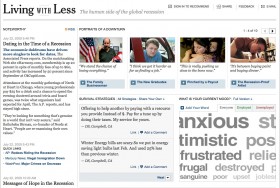 Living with Less
Living with Less
projects.nytimes.com/living-with-less
New York Times Juliet Gorman, Amy O’Leary, Elliott Malkin
The New York Times created the “Living With Less” project in recognition of the need for people-focused coverage of the recession. The page showcases in-depth video and audio portraits of real people whose lives have been upended, taking readers inside a motel room that houses a family of six, or a foreclosure court where stunned defendants wonder about their next move. Their repository of reader-contributed content—more than 78,000 user contributions and interactions with the project’s features—is a “living history of the present turmoil.”
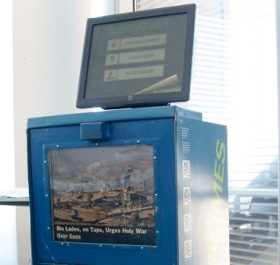 Custom Times
Custom Times
nytlabs.com/customtimes/
New York Times Michael Young, Alexis Lloyd, Ted Roden, Nick Bilton
The New York Times created a prototype called “Custom Times” which offers users a personalized version of The New York Times that seamlessly transitions across multiple platforms: print, web, mobile, tv/living room and the car. The goal of Custom Times is to provide a rich, engaging news reading (and watching) experience that anticipates the user’s needs across devices and environments. Custom Times consists of a interactive newspaper box, a personalized web site, a mobile web site, a TV application and car integration.
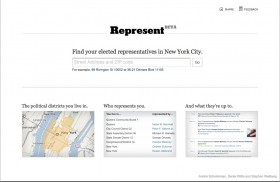 Represent
Represent
prototype.nytimes.com/represent/
New York Times Andrei Scheinkman, Derek Willis
Represent is an interactive feature on nytimes.com that helps New York City residents keep tabs on their elected officials. Represent culls information from dozens of sources across the web into into a Facebook-style activity feed localized to an individual reader. Represent determines a reader’s elected representatives at each level of government—from their local community board up to the U.S. Senate—and provides maps to show how their address fits into the political geography of the city. The application then generates a feed specific to the elected officials representing that address.
$1,000 Special Distinction Awards 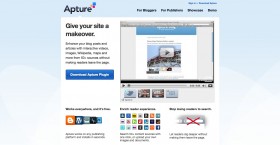 Apture
Apture
www.apture.com/
Powerful multimedia program allows Web content creators to embed images, video, audio and screen grabs into their articles. Content pops up in a small window in the same screen, allowing users to get more information from articles without having to open new windows or tabs or do their own searching. Apture even allows content creator to specify the point that an embedded video should start at or what portion of a document should be captured so that users don’t have to watch a long video or read a large document to see pertinent parts. Other examples: dotearth.blogs.nytimes.com/2009/06/23/whale-watching-trumps-whaling/
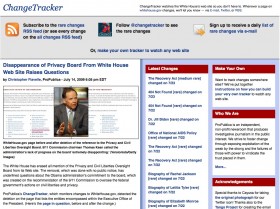 Change Tracker
Change Tracker
www.propublica.org/ion/changetracker
ProPublica developed a Web application called ChangeTracker to monitor www.whitehouse.gov for changes, and provides before-and-after pictures of the site. ChangeTracker was created using easy-to-use, free software so that other organizations could use a similar application to monitor other Web sites. The day after it launched, ChangeTracker disclosed a change on the WhiteHouse.gov Hurricane Katrina page, and later changes on its Iraq policy page. The code for the program has been used almost 100 times.
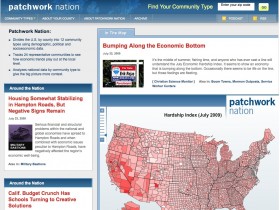 Patchwork Nation
Patchwork Nation
www.pbs.org/newshour/patchworknation/#/archive/?category=hardship&map=hardship-index-july-2009
Patchwork Nation is a Web site shared by the Christian Science Monitor and NewsHour with Jim Lehrer that uses reams of demographic data to break the nation’s 3,100-plus counties into 12 different kind of places, with the idea of studying how different parts of the United States are dealing with an era of dramatic change in politics, culture and the economy. There are 24 communities, two for each type, that they track through citizen bloggers in each place. Along with that street-level reportage they use their community types as a filter for data they collect at the county level. With public broadcasting they have found 15 partner stations. In other communities they have identified local bloggers to help with local news.
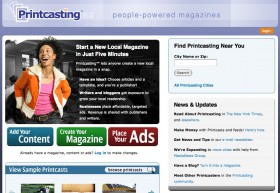 Printcasting
Printcasting
www.printcasting.com/
Printcasting translates a blogging into a physical magazine that printcasters can distribute however they like. Additionally, users can share content with each other across different blogs. Users will also be able to sell advertising and trade content for advertising share.
$1,000 Special Distinction Award for Nonprofit Journalism: Center for Public Integrity
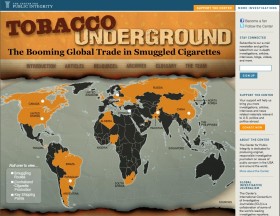 Tobacco Underground
Tobacco Underground
www.publicintegrity.org/investigations/tobacco/
Center for Public Integrity The project uses interactive multimedia channels to expose the black market for tobacco. The stories were integrated with undercover footage; audio and video interviews with experts, smugglers, and undercover agents; maps and charts; and extensive links to resources ranging from tobacco control groups to repositories of tobacco industry documents. The project is produced by 17 journalists in 13 different countries.
 Who’s Behind the Financial Meltdown?
Who’s Behind the Financial Meltdown?
www.publicintegrity.org/investigations/economic_meltdown/
Center for Public Integrity Explaining the faults of the recent financial disaster “Who’s Behind the Financial Meltdown? The top 25 subprime lenders and their Wall Street backers” uses digital media for their Subprime 25, the interactive maps page, and the Share Your Story section. This project included substantive analysis of the public officials and the press, which led to the press and government officials’ recognition.
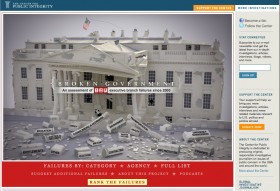 Broken Government
Broken Government
www.publicintegrity.org/investigations/broken_government/
Center for Public Integrity The Center created a list of over 120 “Executive Branch Failures” of the Bush Administration in diverse areas ranging from education to veteran’s affairs, They reached out to 4,800 government employees for their nominations. The project was developed by more than one dozen reporters and involved scores of experts and outside collaboration. The list is searchable and each entry includes critical information and resources.
$1,000 Citizen Media Award
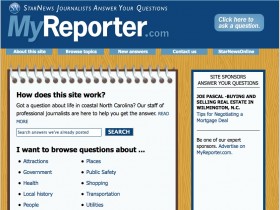 MyReporter
MyReporter
www.myreporter.com/
MyReporter.com is customized WordPress blog that allows readers to pose questions about their community and get answers researched and written by the editorial staff. It works like this: You ask a question in any of three ways: a form on the site, MyReporter.com’s Twitter account or e-mail. Within 24 hours (longer on weekends and holidays), you get a personal response letting you know how they plan to handle your question. The project seeks to reverse the traditional reader-input-follows-the-story-model to a reader-is-in-control-from-the-start model.
Mug Shots
mugshots.tampabay.com
St. Petersburg Times Mug Shots posts mug shots from Tampa Bay County along with biographical information of each arrested individual. This information is available publicly through the Sheriff’s website, but is not user-friendly. Mug Shots is intuitive, simple and visually pleasing. This system is affordable, as a newsroom staff is not needed to gather these public records. In May alone, Mug Shots had 6.9 million page views.
 Demotix
Demotix
www.demotix.com/
London, England Citizen photojournalists and professional freelancers post their photos on Demotix, allowing for them to market themselves outside of traditional outlets. Demotix licenses the best work to newspapers. Users create 100% of the site’s content and monitor for suspicious activity. Over 5,000 users worldwide participate. They say they post 50 stories a day.
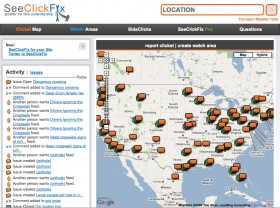 SeeClickFix
SeeClickFix
www.seeclickfix.com/
Over 4200 citizens use SeeClickFix to instantly upload pictures, stories, videos or comments about non-emergency issues in their local areas to the web. These hyperlocal issues are then posted on the web or used as news in various outlets. Almost 900 geographic communities have been represented, resulting in 30 traditional news stories.
 Bank Tracker
Bank Tracker
banktracker. investigativereportingworkshop.org/
Investigative Reporting Workshop, American University The Investigative Reporting Workshop’s BankTracker, done in cooperation with msnbc.com, was the first online tool that permits a user to look up the health of any bank in the nation, using information from the Federal Deposit Insurance Corp. The project simplifies complex data using charts and interactive tools that would not normally be possible through traditional media channels. The partnership with msnbc.com has created substantial site traffic for the project: March 17 through June 7 the site had received more than 128,000 visits and nearly 1.6 million page views.
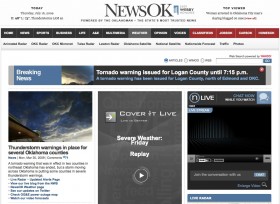 Breaking News
Breaking News
newsok.com/weather/playground
NewsOK–The Oklahoman The Oklahoman and NewsOK.com used Internet chat software to have real-time conversations with audience while streaming live video event coverage. They also blogged and used Twitter to break news faster. During an ice storm, 13,000 people logged into the chat and chatters and Twitter users were directing reporters to specific locations to check driving conditions. Coverage of that storm and of a tornado-producing series of storms each broke 1 million page views in 24 hours.
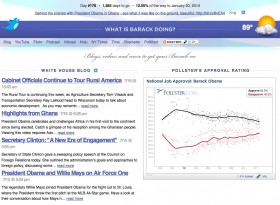 What Is Barack Doing?
What Is Barack Doing?
www.whatisbarackdoing.com
What Is Barack Doing? aggregates presidential news from many different sources, from the major networks to social networks to the White House itself. It uses good Web design practices to increase usability and accessibility.
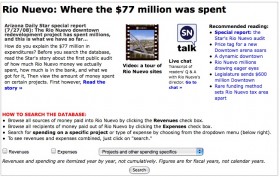 Rio Nuevo Audit
Rio Nuevo Audit
www.azstarnet.com/special/rionuevo-dollars
Arizona Daily Star Arizona Daily Star investigated the Rio Nuevo project and made thousand of paper records available online. The Rio Nuevo project was supposed to revamp Downtown Tucson but since its inception in 1999 little progress, if any, has been made. Because of the ADS’s reporting and investigation, the public has been made aware of the project’s mismanagement and as a result, control of the project has been taken from the City Council by the Arizona Legislature and both the City Manager and Project Director have been fired. The Star’s Rio Nuevo investigations are innovative because they created a detailed and searchable list of what the city had spent redeveloping Downtown—information the public craved and learned for the first time from the paper.
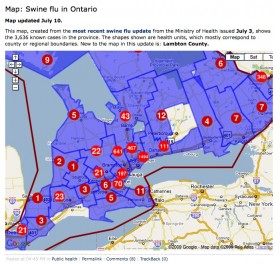 Map of the Week
Map of the Week
thestar.blogs.com/maps/
Toronto Star Map of the Week is an ongoing series of interactive maps on the Toronto Star’s Web site based on the Google Maps API, anchored by a blog (thestar.blogs.com/maps). The subjects range from the serious, like reports of sexually transmitted disease or postal codes of drunk driving suspects, to maps that are just interesting, like dog licences or the range of urban bees. Often the maps are based on open-source data, but more typically are created from information obtained under access-to-information laws.
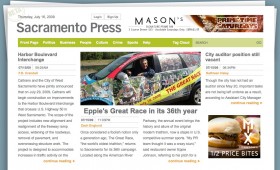 The Sacramento Press
The Sacramento Press
www.sacramentopress.com
Robust local online news site covers Sacramento with contributions from more than 400 volunteer community reporters. The site allows comments and ratings on articles and aggregates relevant RSS feeds. It posts 10-20 new articles each day and receives more than 30,000 visits per month.
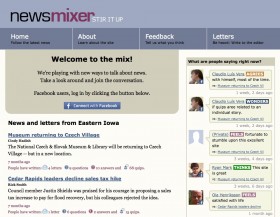 News Mixer
News Mixer
newsmixer.us
Medill School, Northwestern University Six Medill/Northwestern graduate journalism students set out in September 2008 to solve two problems: Improving conversations around news, and building news engagement among young adults. The site uses the Facebook Connect feature to allow users to stay connected via Facebook and post comments. The site concentrates on the Easter Iowa area and is geared toward young adults and high school age teens.
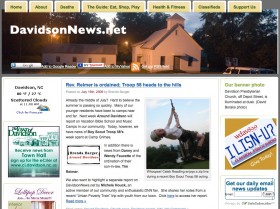 DavidsonNews.net
DavidsonNews.net
www.davidsonnews.net/
DavidsonNews.net is a community news website covering Davidson, N.C. They combine volunteer reporting by veteran journalists with citizen contributions and links to other sites. The site helps build community by providing a common frame of reference, shared stories, and a forum for discussion. DavidsonNews.net covers Town Hall, community events, schools, churches, and other institutions, including the town’s major employer, Davidson College.
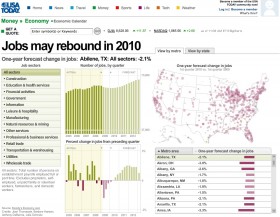 Jobs Database
Jobs Database
www.usatoday.com/money/economy/2009-02-06-new-jobs-growth-graphic_N.htm
USA Today The Jobs Forecast gave readers a unique way to look at predictions by moodys.com about where employment would grow, and in what job categories. The data is displayed on the USA Today page and encourages readers to dig deeper and deeper into the data through rich charts and visuals.
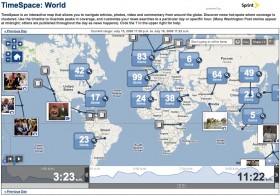 TimeSpace
TimeSpace
Washington Post TimeSpace is a map and timeline interface that displays thousands of media items from around the globe. The interactive map allows users to explore the world and see where news is happening. TimeSpace is a newsroom tool that provides journalist a way to aggregate multiple sources of content and present them in an intuitive map and timeline interface. Currently, there are five versions of TimeSpace presenting more than 10,000 items per day and receiving more than 1 million page views per month.
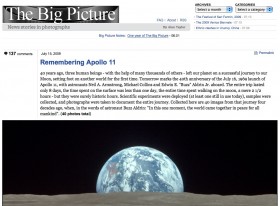 The Big Picture
The Big Picture
www.boston.com/bigpicture/
Boston Globe The Big Picture is a project created to create a home for big pictures, not in gallery form, maximizing the impact of expanding monitors. The site is based around comment sections and uses a blog format to display pictures. Since its inception, several other prominent news companies (Wall Street Journal and New York Times) have created mirror sites to emulate The Big Picture.
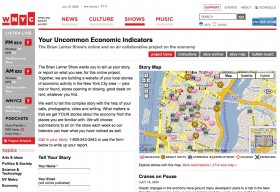 Your Uncommon Economic Indicators
Your Uncommon Economic Indicators
www.wnyc.org/shows/bl/economic_indicators/
WYNC Radio The project is an online project on WNYC.org where listeners spend time on the site and where they come to share stories about the economy. There are multiple ways for visitors to see indicators and share their own including: a drop-box submission form, photos or video, and an address bar that locates the story on a Google map. Viewers can choose from 6 category icons such as Behavior, Housing or Bright Spots, and see each entry or see a photo display and a 26-page (and growing) chronological story archive. Many stories end up on-air as part of WNYC’s economic reporting.
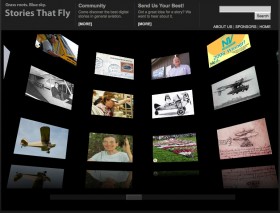 Stories That Fly
Stories That Fly
www.storiesthatfly.com
Kent State University Students, professional and participant journalists work in this online lab to experiment with new approaches to improve the public understanding of general aviation. They feature stories that largely go unnoticed in the regular coverage of environmental, business, health, economy, technology, agriculture, sports and entertainment news. Stories that Fly is an online magazine and blog. Utilizes an enormous amount of internet functionality including but not limited to Twitter, Facebook, Flickr, Youtube and Digg.
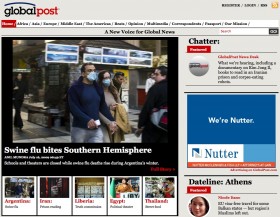 GlobalPost.com
GlobalPost.com
www.globalpost.com
Covering international news with a network of more than 65 correspondents in 45 countries, “GlobalPost” discusses topics of economy, politics, and culture in poorly covered countries. Since its start in January 2009, it has attracted more than 2 million visits from over 200 countries and more than 7,500 other Websites have linked to them. It also provides readers a chance to participate in the editorial process by Passport Stories, which reports are proposed by members, voted on by the membership, and then edited by professional journalists.
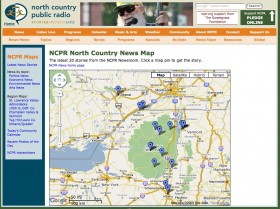 NCPR Dynamic News Maps
NCPR Dynamic News Maps
www.northcountrypublicradio.org/news/newsmap.html
North Country Public Radio North Country Public Radio is creating the “NCPR Dynamic News Maps” project using mapping tools that encode location information into news and events through a content management system, and the use of geoRSS to deliver the content onto maps generated by Google Maps API. In seven days the maps received a 2.74% increase of page views since the first day. The project will use professional and citizen journalists to update information in near to real time to viewers from hundreds of villages, towns and small cities with distinct diverse communities.
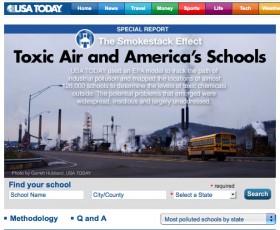 The Smokestack Effect: Toxic Air and America’s Schools
The Smokestack Effect: Toxic Air and America’s Schools
www.smokestack.usatoday.com
USA Today The USA Today investigative team created a searchable database that analyzes what pollutants and health risks children are exposed to at their school. It has received attention from concerned parents, local governments, senators, and the EPA, and has prompted change in air monitoring practices at schools across the country. They claim 1.7 million page views of the database and 8,000 letters to members of Congress.
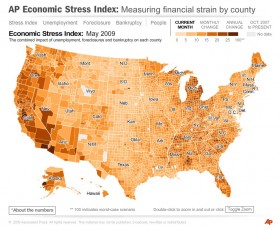 AP Economic Stress Index
AP Economic Stress Index
Associated Press The AP Economic Stress Index combines unemployment, foreclosure, and bankruptcy data down to the county level to create an index of the overall health of the economy. The data are displayed on a clickable map and the data can be mashed up in several ways to dig deep into the numbers.
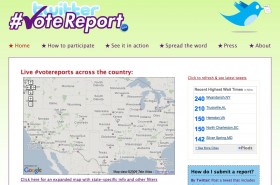 Twitter Vote Report and Inauguration Report
Twitter Vote Report and Inauguration Report
twittervotereport.com
inaugurationreport.com
NPR A free tool for the public to report any voting irregularities they experienced. As reporters could not cover each county on election day, this allowed citizen journalists to instantly submit stories, later outputted through widgets and the web. Over 12,000 reports were received. The same system was used on inauguration day, with over 40,000 reports coming in.






